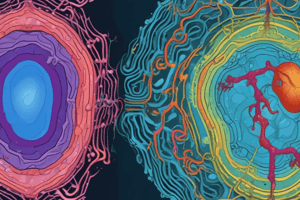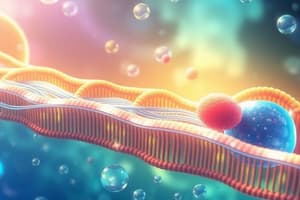Podcast
Questions and Answers
What is the main characteristic of passive transport?
What is the main characteristic of passive transport?
- It requires energy input from the cell.
- It allows molecules to move without energy input. (correct)
- It occurs against the concentration gradient.
- It only transports water molecules.
What factors influence the rate of diffusion?
What factors influence the rate of diffusion?
- Pressure, membrane thickness, and ionic strength
- Temperature, pressure, and concentration gradient
- Size of molecules, concentration gradient, and temperature (correct)
- Molecular weight, pH, and presence of channel proteins
Which best describes osmosis?
Which best describes osmosis?
- The movement of molecules via carrier proteins.
- The diffusion of water across a selectively permeable membrane. (correct)
- The active transport of solutes against their gradient.
- The diffusion of nutrients across a membrane.
What distinguishes active transport from passive transport?
What distinguishes active transport from passive transport?
What type of protein helps molecules cross the membrane without using energy in facilitated diffusion?
What type of protein helps molecules cross the membrane without using energy in facilitated diffusion?
Which of the following statements about enzymes is true?
Which of the following statements about enzymes is true?
What can happen to an enzyme if the temperature exceeds its optimal range?
What can happen to an enzyme if the temperature exceeds its optimal range?
How does substrate concentration affect enzyme activity?
How does substrate concentration affect enzyme activity?
What is the function of channel proteins in facilitated diffusion?
What is the function of channel proteins in facilitated diffusion?
Which method of transport includes actions such as pinocytosis and phagocytosis?
Which method of transport includes actions such as pinocytosis and phagocytosis?
What is the primary function of competitive inhibitors?
What is the primary function of competitive inhibitors?
Which mechanism involves the end product of a metabolic pathway inhibiting an earlier enzyme in that pathway?
Which mechanism involves the end product of a metabolic pathway inhibiting an earlier enzyme in that pathway?
What role does the active site of an enzyme play?
What role does the active site of an enzyme play?
How does non-competitive inhibition affect enzyme activity?
How does non-competitive inhibition affect enzyme activity?
Which statement best describes allosteric regulation?
Which statement best describes allosteric regulation?
What happens during the induced fit model of enzyme activity?
What happens during the induced fit model of enzyme activity?
What is the significance of lowering activation energy in a chemical reaction?
What is the significance of lowering activation energy in a chemical reaction?
Which component in enzyme nomenclature typically indicates an enzyme's function?
Which component in enzyme nomenclature typically indicates an enzyme's function?
What is a characteristic of enzyme activity that is regulated through allosteric sites?
What is a characteristic of enzyme activity that is regulated through allosteric sites?
Which type of inhibition does not directly compete with the substrate for the active site?
Which type of inhibition does not directly compete with the substrate for the active site?
Flashcards
Passive Transport
Passive Transport
Movement of molecules across a membrane without energy input.
Diffusion
Diffusion
Molecules move from high to low concentration.
Osmosis
Osmosis
Water diffusion across a membrane.
Active Transport
Active Transport
Signup and view all the flashcards
Facilitated Diffusion
Facilitated Diffusion
Signup and view all the flashcards
Carrier Protein
Carrier Protein
Signup and view all the flashcards
Channel Protein
Channel Protein
Signup and view all the flashcards
Endocytosis
Endocytosis
Signup and view all the flashcards
Enzyme
Enzyme
Signup and view all the flashcards
Enzyme Specificity
Enzyme Specificity
Signup and view all the flashcards
Enzyme Inhibitors
Enzyme Inhibitors
Signup and view all the flashcards
Competitive Inhibitors
Competitive Inhibitors
Signup and view all the flashcards
Non-competitive Inhibitors
Non-competitive Inhibitors
Signup and view all the flashcards
Enzyme Regulation
Enzyme Regulation
Signup and view all the flashcards
Allosteric Regulation
Allosteric Regulation
Signup and view all the flashcards
Feedback Inhibition
Feedback Inhibition
Signup and view all the flashcards
Active Site
Active Site
Signup and view all the flashcards
Substrate
Substrate
Signup and view all the flashcards
Induced Fit
Induced Fit
Signup and view all the flashcards
Enzyme Naming Convention
Enzyme Naming Convention
Signup and view all the flashcards
Study Notes
Movement of Molecules
- Passive transport: Movement of molecules across a membrane without energy input. This includes diffusion and osmosis.
- Diffusion: Molecules move from an area of high concentration to an area of low concentration. The rate of diffusion is affected by factors like temperature, concentration gradient, and the size of the molecules.
- Osmosis: The diffusion of water across a selectively permeable membrane. Water moves from a region of high water potential to a region of low water potential. Important in maintaining cellular homeostasis.
- Active transport: Movement of molecules across a membrane requiring energy input (usually ATP). Moves substances against their concentration gradient.
- Examples: Sodium-potassium pump, endocytosis, exocytosis.
- Importance: Essential for transporting substances needed by the cell against concentration gradients, like nutrient absorption and removal of waste products.
- Facilitated diffusion: Molecules move down their concentration gradient with the help of transport proteins embedded in the cell membrane. This is a type of passive transport, needing no energy.
- Carrier proteins: Bind to molecules and change shape to move them across the membrane.
- Channel proteins: Create a hydrophilic pore for molecules to pass through. Typically specific for the type of molecule they transport.
- Bulk Transport: Large particles and macromolecules are transported across the membrane.
- Endocytosis: Plasma membrane surrounds the substance and forms a vesicle/vacuole to bring it into the cell. Includes phagocytosis (cell eating) and pinocytosis (cell drinking).
- Exocytosis: Substances are discharged from the cell by fusing vesicles with the plasma membrane. Excretion of waste or release of hormones.
Enzymes
- Biological Catalysts: Speed up chemical reactions in living organisms without being consumed in the process.
- Specificity: Each enzyme is highly specific for a particular substrate. Active site that is shaped to fit with the substrate and catalyzes the reaction.
- Factors Affecting Enzyme Activity:
- Temperature: Optimal temperature exists for each enzyme, where activity is highest. Too high can denature enzymes.
- pH: Each enzyme has an optimal pH range. Changes greatly affect enzyme shape and activity.
- Substrate Concentration: Increasing substrate concentration increases enzyme activity until the enzyme becomes saturated.
- Enzyme Inhibitors: Substances that reduce enzyme activity.
- Competitive inhibitors: Resemble the substrate and compete for the active site.
- Non-competitive inhibitors: Do not resemble the substrate, bind to a different site (allosteric site), causing the enzyme to change shape, and affecting function.
- Enzyme Regulation: Controlling the rate at which enzymes work.
- Allosteric regulation: Molecules bind to regions other than the active site, affecting enzyme shape and activity.
- Feedback inhibition: The end product of a metabolic pathway inhibits the enzyme earlier in the pathway, preventing overproduction.
- Enzyme Structure:
- Active site: Region on the enzyme that binds to the substrate.
- Substrate: The molecule that the enzyme acts upon.
- Product: The resulting molecules formed during the reaction.
- Induced Fit: Enzyme changes shape slightly when substrate binds, forming a tighter interaction for maximum efficiency.
- Naming Conventions:
- Often end with "-ase" like amylase, lipase, catalase.
- Activation energy: Enzymes catalyze reactions by lowering activation energy - the energy needed for the reaction to begin.
Studying That Suits You
Use AI to generate personalized quizzes and flashcards to suit your learning preferences.




